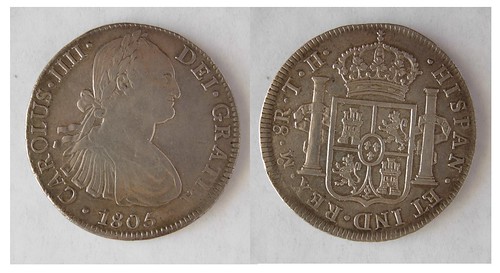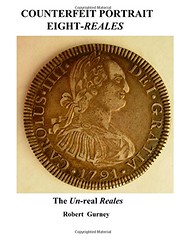
PREV ARTICLE
NEXT ARTICLE
FULL ISSUE
PREV FULL ISSUE
NEW BOOK: COUNTERFEIT PORTRAIT EIGHT-REALESA new book available for sale on Amazon covers
the topic of Counterfeit Portrait Eight-Reales. Here's the
web site blurb (with minor corrections and edits by the author).
-Editor
The portrait style Spanish-American eight-reales was one of the most well-known, and extensively circulated silver trade coins that the world has ever seen. Produced in Spain's new world colonies from 1772 to 1825, the coin made Spain a major player on the world financial stage in the eighteenth and early nineteenth centuries. This was due in large measure to the fact this coin accounted for about sixty percent of the annual silver production worldwide. The popularity and general acceptance of this particular coin – the portrait style piece-of-eight – made it the object of forgers who operated in all areas of the globe. It was a coin not merely counterfeited in the countries of origin, but in all of the places where it was accepted as currency in day-to-day transactions. It was produced in small back-room operations and in large factories. It was produced at times in utter secrecy, yet at other times it was more or less an “open secret.” It was produced as both worthless base metal copies and as “perfect” imitations containing the correct amount of silver. It has been made to circulate as currency, as well as to specifically deceive collectors. The fascinating story of these counterfeit issues created from shortly after the coin appeared until the present, is the subject of this book. The author, Robert Gurney, known to many coin collectors as “Swamper Bob,” has been a lifelong enthusiast of the series. His interest commenced as a teen when he met and spoke to one of the forgers who actually made these coins for a living in the 1920's. The story may at times not seem possible, but the newest scientific tests available provide conclusive evidence for the production of counterfeit versions made for circulation as late as 1930. With contributions made by several notable collectors, including Richard August, John Lorenzo and Gordon Nichols, this book documents the four different classifications of counterfeit eight-reales developed by the author to fit the needs of this particular series. The book illustrates and describes literally hundreds of different types of counterfeits known to have circulated alongside the genuine versions. It specifically expands upon the Thirty-nine varieties noted by Dr. John L. Riddell as existing in circulation in New Orleans in 1845, and swells that number to some 589 varieties. This book was not written just for coin collectors, the subject is actually much broader. It is at its heart a history of the coin covering a period of 240 years of use and production. It is also the story of the methods and reasons for producing both counterfeits and forgeries during that same interval. The players and their motivations for the production of deceptive copies for over 240 years, provides insight into human nature. The book is presented as a start to a long needed discussion - one that is decades overdue. It is only a start. The author hopes that this publication will bring old counterfeits out of their hiding places and into the light of day, where the varieties from childishly crude to artistically superb can be appreciated by everyone. Solamente el comienzo! Product Details Series: Counterfeit Eight-Reales
About the author Robert Richard Gurney is a native son of Massachusetts and a Twelfth generation Yankee, now retired and living in the land of Andy Griffith. Educated as a Civil Engineer, he holds a B.S in Civil Engineering, S.C.L. from the University of Massachusetts, Dartmouth. He is married to his first true love, Elizabeth (Bixler) Gurney and together they have three children. A nearly lifelong coin collector and avid student of history, Gurney has spent decades collecting and analyzing counterfeit coins that circulated as currency in the United States before 1857. Since meeting a self-confessed forger, who claimed to have produced counterfeit silver Mexican eight-reales in the 1920s, Gurney has been fascinated by these “foreign” coins that represented about 90% of the circulating silver specie in the United States before the Civil War. Always a supporter of the UNDERDOG (think the Red Sox in 1967), Gurney hopes to place the eight-reales counterfeit coins on an even footing with other series of counterfeit coins seen as being collectable. He views the Contemporary Counterfeit Portrait Eight-Reales as a long neglected underdog in the world of numismatics. Noting that the book is described as
"Volume 1", I asked Bob about his future plans. He
supplied the following background on the project, including
negotiations with the American Numismatic Society on its
publishing. Thanks! -Editor
Regarding my second volume - I plan to produce a volume devoted to the Cap and Ray counterfeits. My emphasis there will be on the varieties similar to the coins listed in Riddell's "Monograph of the Silver Dollar, Good and Bad" from 1845 and I plan to extend those listings to coins dated as late as the end of the first republic ca 1862. If time (my time on earth) allows I then plan to expand the coverage of the Cap and Ray counterfeits into the period of the second Republic and through 1897. I actually started with the Portrait coin book project because that opportunity was presented to me first. The project, as I currently understand the process, was initially developed by the former curator of the ANS (Mr. Hoge) in conjunction with Mike Ringo, John Lorenzo and Gordon Nichols. The primary author was to be Mike Ringo. After Mike's death, I was asked to get involved. It began as a collaborative effort at first, but in the long run I became primary author by agreement of the others. John Lorenzo was to write the coin descriptions and he also wrote the sections on metal analysis and XRF testing. Gordon Nichols did the initial die classifications for 120 coins using the ANS preferred system which treated obverse and reverse dies independently. This method has been shown to work with Half Pennies and Two reales and it was assumed that it would be good for the Portrait 8Rs as well. As time passed and the book grew, I felt we had to scrap the system in favor of a model (similar to Davignon) that linked the two dies into mated pairs of date AND mint taken together. This was necessary because the vast majority of contemporary counterfeit portrait coins carry the Mexico City mint mark and because sharing of dies was clearly not as commonplace among the dollar sized coins as it was for half pennies or Two reales. Where most half pennies share dies in nearly 50% of cases and two reales share dies in over one third of cases - the 8Rs share dies in only 5% of cases. I chose to use mated pairs because it represented 95% of all cases. One of the critical elements of the book which led to the American Numismatic Society backing out of publishing the book (with my wholehearted agreement) was that I wanted to include the topic of the silver counterfeits made from 1830-1930 for the China trade. ANS saw the "story" as unbelievable even though I have historic documentary evidence and scientific testing to support my theories. Of course I also had a chuckle for myself because the person doing the review for ANS believed that the coin I used on both front and rear covers of the book was REAL. It is actually a Sheffield plate counterfeit confirmed by both XRF tests and Specific Gravity. It has under 60% of the appropriate silver content and has a clear ribbon seam in the dentils. Yet the reviewer said we were wrong to identify the coin as a counterfeit since it was most likely genuine. There were a few other critical issues where I could not see eye to eye with ANS either. I wanted to list coin-like-objects such as buttons, religious, political medals, hobo-carvings, replicas and other uses (using one or two examples of each type) just to spur interest in those collectables. ANS wanted to reduce the section to one page. I wanted to define terms and create a glossary for things like "colonial" to distinguish between US colonial (ends 1776 to 1781) and Spanish colonial (ends 1820 - 1830). ANS wanted to use existing terms as they are currently used because that was adequate and my definitions were confusing. I chose to list four types of fraudulent or unlawful coins - Contemporary Circulating (base metal) - Contemporary Circulating (silver) - Numismatic Forgeries (made for collectors) and Frauds (mined or doctored coins etc.). However ANS saw no value in that and preferred only two classes contemporary and modern counterfeits. I chose to include complete typescripts of Riddell (1845) and Bordeaux (1905) because the texts of both works needs to be readily at hand for understanding the book. ANS wanted those eliminated because they could be found elsewhere. I wanted to use descriptions of the coins that relied on the use of pictures backed up by available Disc copies of all the coins but ANS wanted detailed written descriptions of each coin so they could be identified without pictures. The ANS rejection was for me a blessing. It allowed me to go further afield and to include necessary discussion points - things beginning collectors need to know and understand. ANS and I wanted to produce different books for different audiences. The split was absolutely necessary. Anyway that is why and how things reached this point. I have always wanted to do a book on the early Cap and Ray Counterfeit coins because I started collecting them first when I was a pre-teen. I did not even own a counterfeit Portrait 8R until 1960. I also have a much larger collection of Cap and Ray 8R counterfeits (3,600) compared to just about 600 Portrait 8R coins so I have much more to work with as far as raw material goes. I also view the counterfeiting of the Cap and Ray coins as far more straight forward an activity than the Portraits because the C&R 8Rs did not have the market driver caused by the premium paid by the Chinese for Charles IV 8Rs from Mexico City.  Here's a picture of the first counterfeit Portrait counterfeit that I got from a self-confessed counterfeiter in 1960-2 who said he made it in Massachusetts the 1920s. The coin has been proven to have too little gold as a contaminant (to have been made in 1805) by two different XRF laboratories and this coin is the basis for my belief that full weight silver counterfeits were produced for the China trade as late as 1930. A recent test run at RTI International has returned a preliminary signature match with an example of the 1896-O micro O Morgan dollar. I am resubmitting both coins to RTI next week for XRF re-testing with a brand new state of the art XRF testing machine which will do far finer analysis of the trace contamination (down to 1 ppm for 72 elements) in the hopes of proving that the source of both coins is identical. For more information, or to order, see:
Wayne Homren, Editor The Numismatic Bibliomania Society is a non-profit organization promoting numismatic literature. See our web site at coinbooks.org. To submit items for publication in The E-Sylum, write to the Editor at this address: whomren@gmail.com To subscribe go to: https://my.binhost.com/lists/listinfo/esylum All Rights Reserved. NBS Home Page Contact the NBS webmaster 
|
